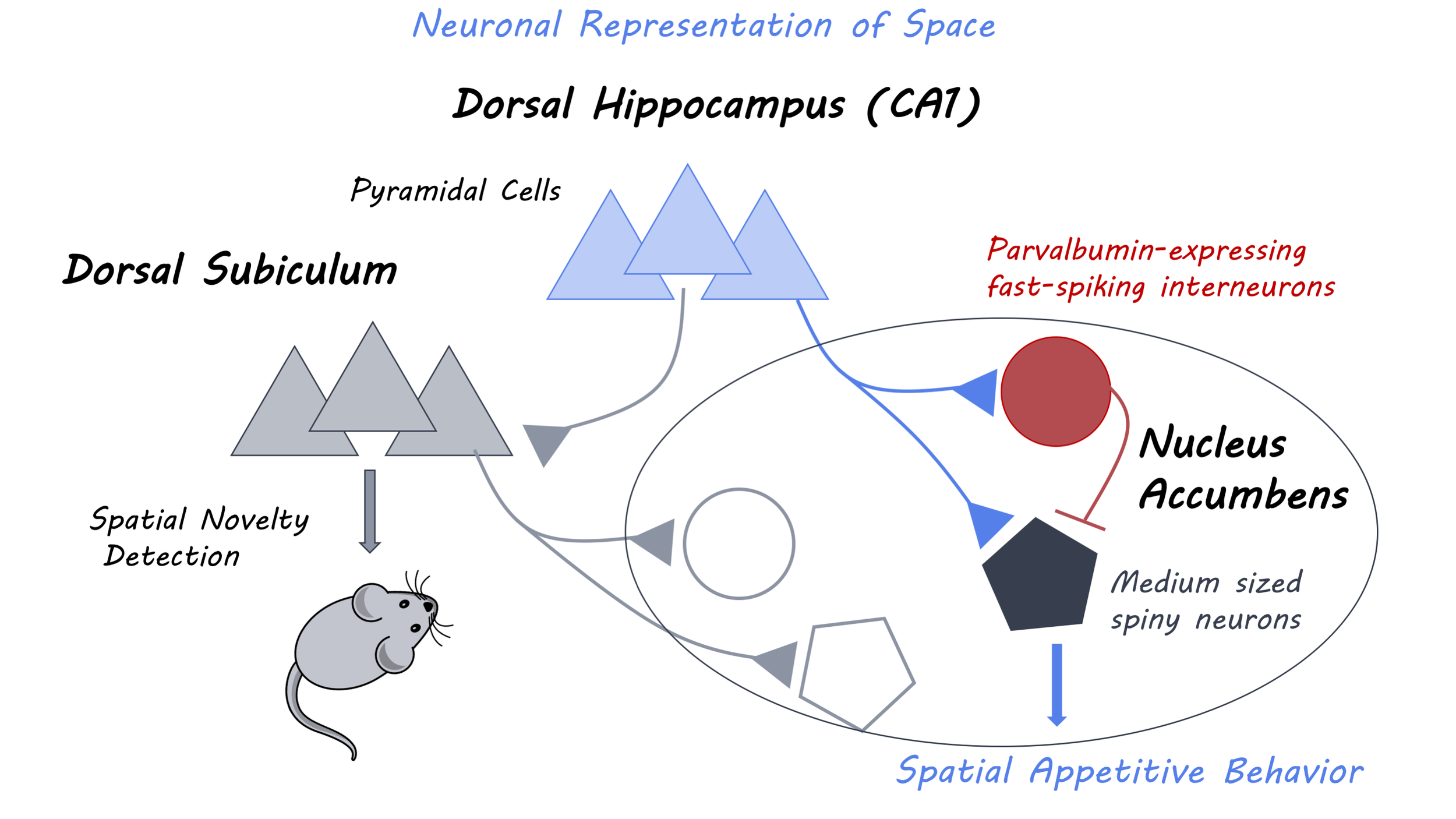Hippocampal-Accumbens Pathway Drives Memories of Reward-Seeking Behavior
Post by Lincoln Tracy
What's the science?
Being able to recall specific memories of where to find food – a reward-seeking behavior – is a fundamental part of survival. In mammals, pyramidal cells in the dorsal hippocampus store memories of the environment around us. The nucleus accumbens (part of the ventral striatum) plays an important role in connecting memory and the motor system to process reward-driven behaviors such as eating. Research suggests suggesting a functional connection between the dorsal hippocampus and the nucleus accumbens, however, little is known about whether hippocampal pyramidal cells and nucleus accumbens neurons are connected to one another and how they interact. This week in Cell, Trouche and colleagues used in vivo electrophysiological recordings, viral vector-mediated tracing, and intersectional trans-synaptic optogenetics to understand how hippocampal pyramidal cells interact with nucleus accumbens neurons to use memories of the surrounding environment in reward-seeking behavior.
How did they do it?
The authors first used electron microscopy to investigate whether hippocampal pyramidal cells connect and interact with nucleus accumbens neurons by labelling pyramidal cells in mice with green fluorescent protein. Next, the authors investigated whether pyramidal cell activity was required for using memories of the surrounding environment in reward-seeking behavior. They used a conditioned place preference task in which mice formed memories between entering one of two different chambers and a reward (sucrose). The conditioned place preference task involved three stages: (1) a pre-test session to determine which chamber the mice preferred without any stimulus or reward present; (2) a conditioning session in which the mice explored their non-preferred chamber (using sucrose as bait) and then their preferred chamber (using water as bait); and (3) a test session where conditioned place preference memory was assessed –whether the mice spent more time in the chamber that contained sucrose or the one that contained water. The authors implanted electrodes in the CA1 region of the dorsal hippocampus to record pyramidal cell activity while the mouse completed the conditioned place preference task. They also implanted optic fibers in the dorsal hippocampus and nucleus accumbens so they could use light to turn off different cells in these brain regions (i.e., pyramidal cells and parvalbumin-expressing interneurons).
What did they find?
The authors found a direct pathway connecting hippocampal pyramidal cells to nucleus accumbens medium spiny neurons, providing the first evidence for a link between dorsal hippocampal pyramidal cells and nucleus accumbens neurons. Electrode recordings revealed patterns of dorsal hippocampal pyramidal cell activity during the pre-test component of the conditioned place preference task, representative of the mice forming memories about the different chambers. These firing patterns returned during the test phase of the conditioned place preference task, coinciding with the amount of time spent in the sucrose-containing chamber. When the dorsal hippocampal pyramidal cells were silenced via the optic fibers, the mice spent less time in the sucrose-containing chamber – and the dorsal hippocampal firing patterns decreased during the test phase of the task.
Therefore, remembering the location of sucrose – and subsequently seeking the sucrose out depended on dorsal hippocampal pyramidal cell firing. When the axon terminals of the pyramidal cells in the nucleus accumbens were silenced during the conditioned place preference test phase the mice still explored the two chambers – but they spent less time in the sucrose-containing chamber. When the authors silenced parvalbumin-expressing interneurons in the nucleus accumbens they saw the same result – the mice explored the conditioned place preference apparatus but spent less time in the sucrose-containing chamber during the test phase. These results suggest that interrupting the hippocampal-nucleus accumbens pathway prevented the ability to form and use memories of the surrounding environment in reward seeking behavior.
What's the impact?
This study provides evidence that the dorsal hippocampal – nucleus accubmens pathway represents an interaction point between memory and motor processes when recalling information about reward-seeking behavior. Pyramidal cells from the hippocampus connect to medium spiny neurons and parvalbumin-expressing interneurons in the nucleus accumbens – and all three cell types are required in using spatial memory to drive reward seeking behavior. This study suggests that this pathway could be important in several aspects of linking memory and motor behavior.
Trouche et al. A hippocampus-accumbens tripartite neuronal motif guides appetitive memory in space. Cell (2019).Access the original scientific publication here.

